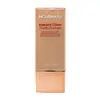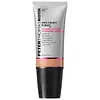What's inside
What's inside
 Key Ingredients
Key Ingredients

 Benefits
Benefits

 Concerns
Concerns

 Ingredients Side-by-side
Ingredients Side-by-side

Water
Skin ConditioningCyclopentasiloxane
EmollientDimethicone
EmollientButylene Glycol
HumectantGlycerin
HumectantSilica
AbrasiveSynthetic Fluorphlogopite
Polysilicone-11
PEG-10 Dimethicone
Skin ConditioningPolysorbate 60
EmulsifyingIsononyl Isononanoate
EmollientHydroxyethyl Acrylate/Sodium Acryloyldimethyl Taurate Copolymer
Emulsion StabilisingIsohexadecane
EmollientPhenoxyethanol
PreservativeSqualane
EmollientSorbitan Stearate
EmulsifyingCarbomer
Emulsion StabilisingMica
Cosmetic ColorantTocopheryl Acetate
AntioxidantEthylhexylglycerin
Skin ConditioningSodium Hyaluronate
HumectantSucrose Cocoate
EmulsifyingSorbitan Isostearate
EmulsifyingDisodium EDTA
Titanium Dioxide
Cosmetic ColorantCI 77499
Cosmetic ColorantCI 77491
Cosmetic ColorantTin Oxide
AbrasiveWater, Cyclopentasiloxane, Dimethicone, Butylene Glycol, Glycerin, Silica, Synthetic Fluorphlogopite, Polysilicone-11, PEG-10 Dimethicone, Polysorbate 60, Isononyl Isononanoate, Hydroxyethyl Acrylate/Sodium Acryloyldimethyl Taurate Copolymer, Isohexadecane, Phenoxyethanol, Squalane, Sorbitan Stearate, Carbomer, Mica, Tocopheryl Acetate, Ethylhexylglycerin, Sodium Hyaluronate, Sucrose Cocoate, Sorbitan Isostearate, Disodium EDTA, Titanium Dioxide, CI 77499, CI 77491, Tin Oxide
Water
Skin ConditioningGlycerin
HumectantButylene Glycol
HumectantIsononyl Isononanoate
EmollientCitrus Aurantium Bergamia Fruit Water
Skin ConditioningDimethicone
EmollientButyrospermum Parkii Butter
Skin ConditioningCaprylic/Capric Triglyceride
MaskingGlyceryl Stearate
EmollientPolyglyceryl-6 Distearate
EmulsifyingCetearyl Alcohol
EmollientSorbitan Stearate
EmulsifyingIsostearyl Alcohol
EmollientMica
Cosmetic ColorantButylene Glycol Cocoate
EmulsifyingBacillus/Soybean Ferment Extract
Skin ConditioningDiamond Powder
AbrasiveNiacinamide
SmoothingSodium Hyaluronate
HumectantSodium Hydroxide
BufferingCitric Acid
BufferingGlutamic Acid
HumectantGlycine
BufferingHistidine
HumectantIsoleucine
Skin ConditioningLeucine
Skin ConditioningLysine
Skin ConditioningPhenylalanine
MaskingAlanine
MaskingArginine
MaskingProline
Skin ConditioningSerine
MaskingThreonine
Tyrosine
MaskingValine
MaskingSodium Phytate
Sodium Lactate
BufferingSilica
AbrasiveEthylcellulose
Potassium Sorbate
PreservativeSodium Benzoate
MaskingHydroxyethylcellulose
Emulsion StabilisingAspartic Acid
MaskingDisodium Phosphate
BufferingPolysorbate 60
EmulsifyingSodium Phosphate
BufferingPolysilicone-11
Titanium Dioxide
Cosmetic ColorantEthylhexylglycerin
Skin ConditioningDimethicone Crosspolymer
Emulsion StabilisingCarbomer
Emulsion StabilisingPolymethylsilsesquioxane
Iron Oxides
Phenoxyethanol
PreservativeWater, Glycerin, Butylene Glycol, Isononyl Isononanoate, Citrus Aurantium Bergamia Fruit Water, Dimethicone, Butyrospermum Parkii Butter, Caprylic/Capric Triglyceride, Glyceryl Stearate, Polyglyceryl-6 Distearate, Cetearyl Alcohol, Sorbitan Stearate, Isostearyl Alcohol, Mica, Butylene Glycol Cocoate, Bacillus/Soybean Ferment Extract, Diamond Powder, Niacinamide, Sodium Hyaluronate, Sodium Hydroxide, Citric Acid, Glutamic Acid, Glycine, Histidine, Isoleucine, Leucine, Lysine, Phenylalanine, Alanine, Arginine, Proline, Serine, Threonine, Tyrosine, Valine, Sodium Phytate, Sodium Lactate, Silica, Ethylcellulose, Potassium Sorbate, Sodium Benzoate, Hydroxyethylcellulose, Aspartic Acid, Disodium Phosphate, Polysorbate 60, Sodium Phosphate, Polysilicone-11, Titanium Dioxide, Ethylhexylglycerin, Dimethicone Crosspolymer, Carbomer, Polymethylsilsesquioxane, Iron Oxides, Phenoxyethanol
Ingredients Explained
These ingredients are found in both products.
Ingredients higher up in an ingredient list are typically present in a larger amount.
Butylene Glycol (or BG) is used within cosmetic products for a few different reasons:
Overall, Butylene Glycol is a safe and well-rounded ingredient that works well with other ingredients.
Though this ingredient works well with most skin types, some people with sensitive skin may experience a reaction such as allergic rashes, closed comedones, or itchiness.
Learn more about Butylene GlycolCarbomer is a polymer of acrylic acid. Its main role is to create a gel consistency.
A high amount of carbomer can cause pilling or balling up of products. Don't worry, most products contain 1% or less of carbomer.
Dimethicone is a type of synthetic silicone created from natural materials such as quartz.
What it does:
Dimethicone comes in different viscosities:
Depending on the viscosity, dimethicone has different properties.
Ingredients lists don't always show which type is used, so we recommend reaching out to the brand if you have questions about the viscosity.
This ingredient is unlikely to cause irritation because it does not get absorbed into skin. However, people with silicone allergies should be careful about using this ingredient.
Note: Dimethicone may contribute to pilling. This is because it is not oil or water soluble, so pilling may occur when layered with products. When mixed with heavy oils in a formula, the outcome is also quite greasy.
Learn more about DimethiconeEthylhexylglycerin (we can't pronounce this either) is commonly used as a preservative and skin softener. It is derived from glyceryl.
You might see Ethylhexylglycerin often paired with other preservatives such as phenoxyethanol. Ethylhexylglycerin has been found to increase the effectiveness of these other preservatives.
Glycerin is already naturally found in your skin. It helps moisturize and protect your skin.
A study from 2016 found glycerin to be more effective as a humectant than AHAs and hyaluronic acid.
As a humectant, it helps the skin stay hydrated by pulling moisture to your skin. The low molecular weight of glycerin allows it to pull moisture into the deeper layers of your skin.
Hydrated skin improves your skin barrier; Your skin barrier helps protect against irritants and bacteria.
Glycerin has also been found to have antimicrobial and antiviral properties. Due to these properties, glycerin is often used in wound and burn treatments.
In cosmetics, glycerin is usually derived from plants such as soybean or palm. However, it can also be sourced from animals, such as tallow or animal fat.
This ingredient is organic, colorless, odorless, and non-toxic.
Glycerin is the name for this ingredient in American English. British English uses Glycerol/Glycerine.
Learn more about GlycerinIsononyl Isononanoate is a synthetic skin-conditioner and texture enhancer. It is created from nonanoic acid, a fatty acid found in cocoa and lavender oil.
As an emollient, Isononyl Isononanoate helps keep your skin soft and smooth. This is because emollients create a barrier on the skin to trap moisture in.
Isononyl Isononanoate helps give products a velvet feel and improves spreadability.
Learn more about Isononyl IsononanoateMica is a naturally occurring mineral used to add shimmer and color in cosmetics. It can also help improve the texture of a product or give it an opaque, white/silver color.
Serecite is the name for very fine but ragged grains of mica.
This ingredient is often coated with metal oxides like titanium dioxide. Trace amounts of heavy metals may be found in mica, but these metals are not harmful in our personal products.
Mica has been used since prehistoric times throughout the world. Ancient Egyptian, Indian, Greek, Roman, Aztec, and Chinese civilizations have used mica.
Learn more about MicaPhenoxyethanol is a preservative that has germicide, antimicrobial, and aromatic properties. Studies show that phenoxyethanol can prevent microbial growth. By itself, it has a scent that is similar to that of a rose.
It's often used in formulations along with Caprylyl Glycol to preserve the shelf life of products.
Polysilicone-11 is a film-forming silicone that creates a non-tacky and matte finish on the skin. It's commonly used to improve texture, absorb excess oil, and help active ingredients spread evenly.
Due to its "rubber-like" structure, it stays on the skin's surface instead of being absorbed. On the skin, it creates a flexible layer that enhances wearability and stability.
Polysorbate 60 is used to help stabilize products. It is a surfactant and emulsifier. These properties help keep ingredients together in a product. Surfactants help reduce surface tension between ingredients with different states, such as liquids and solids. Emulsifiers help prevent oils and waters from separating.
Polysorbate 60 is sorbitol-based and created from the ethoxylation of sorbitan. Ethoxylation is a chemical reaction used to add ethylene oxide. Sorbitan is a the dehydrated version of sorbitol, a sugar found in fruits.
In this case, the 60 comes from reacting 60 units of ethylene oxide with sorbitan.
Polysorbates are commonly used in medicine and foods.
Learn more about Polysorbate 60Silica, also known as silicon dioxide, is a naturally occurring mineral. It is used as a fine, spherical, and porous powder in cosmetics.
Though it has exfoliant properties, the function of silica varies depending on the product.
The unique structure of silica enhances the spreadability and adds smoothness, making it a great texture enhancer.
It is also used as an active carrier, emulsifier, and mattifier due to its ability to absorb excess oil.
In some products, tiny microneedles called spicules are made from silica or hydrolyzed sponge. When you rub them in, they lightly polish away dead skin layers and enhance the penetration of active ingredients.
Learn more about SilicaSodium Hyaluronate is hyaluronic acid's salt form. It is commonly derived from the sodium salt of hyaluronic acid.
Like hyaluronic acid, it is great at holding water and acts as a humectant. This makes it a great skin hydrating ingredient.
Sodium Hyaluronate is naturally occurring in our bodies and is mostly found in eye fluid and joints.
These are some other common types of Hyaluronic Acid:
Learn more about Sodium HyaluronateSorbitan Stearate comes from sorbitol and stearic acid. Sorbitol is a type of sugar and stearic acid is a fatty acid.
It is used as an emulsifier and helps ingredients stay together by creating water-in-oil emulsions.
This ingredient may not be Malassezia folliculitis, or fungal-acne safe.
Titanium dioxide is a mineral UV filter widely used in sunscreens and cosmetics.
It is one of only two UV filters officially classified as “mineral” by regulatory agencies, the other being zinc oxide.
Titanium dioxide provides broad-spectrum protection mostly in the UVB and UVAII range, with some protection in the UVAI range.
While its UVA protection isn’t as strong as zinc oxide’s, the difference is minor.
A common myth is that mineral UV filters reflect UV light. However, modern research shows titanium dioxide absorbs UV radiation like chemical filters (~95% absorption & 5% reflection).
Thanks to its non-irritating nature, titanium dioxide is suitable for sensitive, acne-prone, or redness-prone skin. It is unlikely to cause "eye sting" like other sunscreen ingredients.
A major drawback of this ingredient is its white cast and thick texture. This is why mineral sunscreens often leave a white cast and are less cosmetically elegant than chemical/hybrid sunscreens.
To improve white cast and spreadability, micronized or nano-sized titanium dioxide is often used.
There are ongoing concerns surrounding nano-titanium oxide's impact on marine ecosystems.
There is no conclusive evidence that any form of titanium oxide (or any other sunscreen ingredients) will cause harm to marine ecosystems or coral reefs. The science is still developing but many consumers are keeping a close eye on this issue.
Please note, many destinations have reef-safety sunscreen rules. For instance, the U.S. Virgin Islands advises all visitors to use non-nano mineral sunscreens.
Nano mineral sunscreens once raised safety concerns about absorption into skin.
Extensive research has shown that they do not penetrate healthy or damaged skin; they remain safely on the surface and the top layer of dead skin (stratum corneum).
You'll likely find titanium dioxide bundled with alumina, silica, or dimethicone. These ingredients help make titanium dioxide highly photostable; this prevents it from interacting with other formula components under UV light.
Learn more about Titanium DioxideWater. It's the most common cosmetic ingredient of all. You'll usually see it at the top of ingredient lists, meaning that it makes up the largest part of the product.
So why is it so popular? Water most often acts as a solvent - this means that it helps dissolve other ingredients into the formulation.
You'll also recognize water as that liquid we all need to stay alive. If you see this, drink a glass of water. Stay hydrated!
Learn more about Water